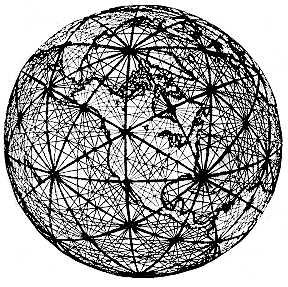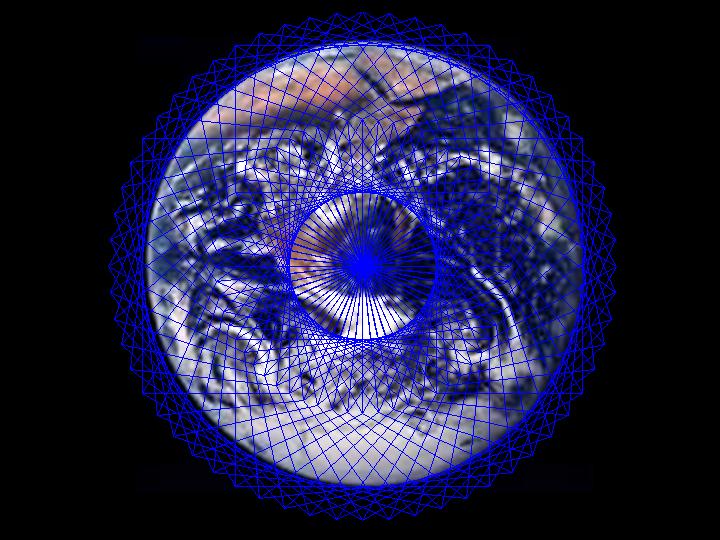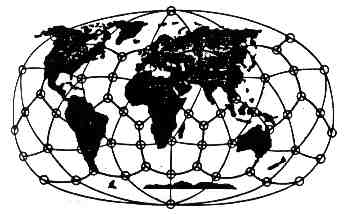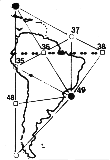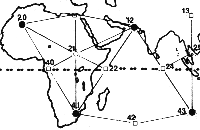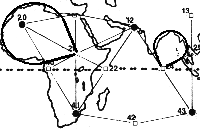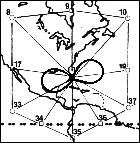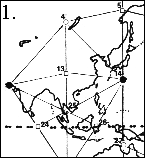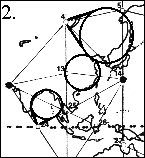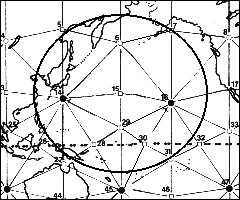Description
This global electromagnetic resonance phenomenon is named after physicist Winfried Otto Schumann who predicted it mathematically in 1952. Schumann resonance occurs because the space between the surface of the Earth and the conductive ionosphere acts as a waveguide. The limited dimensions of the Earth cause this waveguide to act as a resonant cavity for electromagnetic waves in the ELF band. The cavity is naturally excited by energy from lightning strikes. Schumann resonance modes are observed in the power spectra of the natural electromagnetic background noise, as separate peaks at extremely low frequencies (ELF) around 7.8, 14.3, 20.8, 27.3 and 33.8 Hz.
The fundamental mode of the Schumann resonance is a standing wave in the Earth-ionosphere cavity with a wavelength equal to the circumference of the Earth. This lowest-frequency (and highest-intensity) mode of the Schumann resonance occurs at a frequency of approximately 7.8 Hz. Further resonance modes appear at approximately 6.5 Hz intervals, a characteristic attributed to the atmosphere's spherical geometry. The peaks exhibit a spectral width of approximately 20% on account of the damping of the respective modes in the dissipative cavity. The eighth overtone lies at approximately 59.9 Hz.
Schumann resonances are used to track global lightning activity. Owing to the connection between lightning activity and the Earth's climate they can also be used to monitor global temperature variations and variations of upper water vapor. Extraterrestrial lightning may also be detected and studied with Schumann resonances. Schumann resonances have been used for research and monitoring of the lower ionosphere on Earth and was suggested for exploration of lower ionosphere parameters on celestial bodies. Schumann resonances can be used to track geomagnetic and ionospheric disturbances. More recently, Schumann resonances have been used for monitoring transient luminous events sprites, elves, jets, and other upper-atmospheric lightning. A new field of interest using Schumann resonances is related to short-term earthquake prediction. Schumann resonances have gone beyond the boundaries of physics, invading medicine, raising interest in artists and musicians, and gaining interest from fringe fields such as psychobiology.
[edit] History
The first suggestion that an ionosphere existed, capable of trapping electromagnetic waves, was made by Heaviside and Kennelly in 1902 [1] [2]. It took another twenty years before Edward Appleton and Barnett in 1925 [3], were able to prove experimentally the existence of the ionosphere. However, even prior to this, the first documented observations of global electromagnetic resonances were made by Nikola Tesla in 1905 and formed the basis for his scheme for wireless energy transmission [4]. Although some of the most important mathematical tools for dealing with spherical waveguides were developed by Watson in 1918 [5], it was Winfried Otto Schumann who first studied the theoretical aspects of the global resonances of the earth-ionosphere waveguide system, known today as the Schumann resonances. In 1952-1954 Schumann, together with Köning, attempted to measure the resonant frequencies [6] [7] [8] [9] . However, it was not until measurements made by Balser and Wagner in 1960-1963 [10] [11] [12] [13] [14] that adequate analysis techniques were available to extract the resonance information from the background noise. Since then there has been an increasing interest in Schumann resonances in a wide variety of fields.
[edit] Basic Theory
Lightning discharges are considered as the primary natural source of Schumann resonances. Lightning channels behave like a huge antenna which radiates electromagnetic energy as impulsive signals at frequencies below about 100 kHz [15]. These signals are very weak, but the earth-ionosphere waveguide behaves like a resonator at ELF frequencies and amplifies the spectral signals from lightning at the resonance frequencies [15].
In an ideal cavity, the resonant frequency of the n-th mode fn is determined by the Earth radius a and the speed of light c [6].
The real Earth-ionosphere waveguide is not a perfect electromagnetic cavity. Losses due to finite ionosphere electrical conductivity make the system resonate at lower frequencies than would be expected in an ideal case, and the observed peaks are wide. In addition there are a number of horizontal asymmetries day-night transition, latitudinal changes in the Earth magnetic field, sudden ionospheric disturbances, polar cap absorption, etc. that complicate the Schumann resonance power spectra.
[edit] Measurements
Today Schumann resonances are recorded by many stations around the world. The electromagnetic sensors used to measure Schumann resonances consist of two horizontal antennas for receiving the magnetic field in the north-south and the east-west direction and one vertical antenna for observing the vertical electric field. Since Schumann resonance frequencies are extremely low, practical antennas would have to be hundreds of kilometers long. In addition, the Schumann resonance electric field amplitude (~300 microVolts/m) is much smaller than the static electric field (~150 V/m) in the atmosphere. Similarly, the amplitude of the Schumann resonance magnetic field (~1 picoTesla) is orders of magnitude smaller than the Earth magnetic field (~30-50 microTesla) [16] . Therefore, special receivers and antennas are needed to measure Schumann resonances. The electric component is commonly measured with a ball antenna, suggested by Ogawa et al. in 1966 [17] , connected to a high-impedance amplifier. The magnetic field is measured with magnetic induction coils consisting of tens of thousands of turns around material with very high magnetic permeability.
[edit] Applications
[edit] Global lightning activity
From the very beginning of Schumann resonance studies, they were used to monitor global lightning activity by tracking changes in Schumann resonance field intensities. At any given time there are about 2000 thunderstorms around the globe [18]. Producing ~50 lightning events per second [19], these thunderstorms create the background Schumann resonance signal.
Determining the spatial lightning distribution from Schumann resonance records is a complex problem: in order to properly estimate the lightning intensity from Schumann resonance records it is necessary to account for both the distance to lightning sources as well as the wave propagation between the source and the observer. The common approach is to make a preliminary assumption on the spatial lightning distribution, basing on the known properties of lightning climatology. An alternative approach is placing the receiver at the North or South Pole, which remain approximately equidistant from the main thunderstorm centers during the day [20]. One method not requiring preliminary assumptions on the lightning distribution [21] is based on the decomposition of the average background Schumann resonance spectra, utilizing ratios between the average electric and magnetic spectra and between their linear combinations.
[edit] Diurnal variations
The best documented and the most debated features of the Schumann resonance phenomenon are the diurnal variations of the background Schumann resonance power spectrum.
A characteristic Schumann resonance diurnal record reflects the properties of both global lightning activity and the state of the earth-ionosphere cavity between the source region and the observer. The vertical electric field, which is equally sensitive in all directions and therefore measures the global lightning, shows three dominant maxima, associated with the three hot spots of planetary lightning activity: 9 UT (Universal Time) peak, linked to the increased thunderstorm activity from south-east Asia; 14 UT peak associated with the peak in African lightning activity; and the 20 UT peak resulting for the increase in lightning activity in South America. The time and amplitude of the peaks vary throughout the year, reflecting the seasonal changes in lightning activity.
[edit] Chimney ranking
In general, the African peak is the strongest, reflecting the major contribution of the African chimney to the global lightning activity. The ranking of the two other peaks Asian and American is the subject of a vigorous dispute among Schumann resonance scientists. Experimental Schumann resonance data show a greater contribution from Asia than from South America. This contradicts optical satellite and climatological lightning data that show the South American thunderstorm center stronger than the Asian center [19]. The reason for such disparity remains unclear. Williams and Sátori [22] suggest that in order to obtain correct Asia-America chimney ranking, it is necessary to remove the influence of the day/night variations in the ionospheric conductivity (day-night asymmetry influence) from the Schumann resonance records. On the other hand, such corrected records presented in the work by Sátori et al. [23] show that even after the removal of the day-night asymmetry influence from Schumann resonance records, the Asian contribution remains greater than American. Similar results were obtained by Pechony et al. [24] who calculated Schumann resonance fields from satellite lightning data. Both simulations those neglecting the day-night asymmetry, and those taking this asymmetry into account, showed same Asia-America chimney ranking. As for today, the reason for the invert ranking of Asia and America chimneys in Schumann resonance records remains unclear and the subject requires further, targeted research.
[edit] Influence of the day-night asymmetry
In the early literature the observed diurnal variations of Schumann resonance power were explained by the variations in the source-receiver (lightning-observer) geometry [10]. It was concluded that no particular systematic variations of the ionosphere (which serves as the upper waveguide boundary) are needed to explain these variations [25]. Subsequent theoretical studies supported the early estimations of the small influence of the ionosphere day-night asymmetry (difference between day-side and night-side ionosphere conductivity) on the observed variations in Schumann resonance field intensities [26].
The interest in the influence of the day-night asymmetry in the ionosphere conductivity on Schumann resonances gained a new strength in the 1990s, after publication of a work by Sentman and Fraser [27]. Sentman and Fraser developed a technique to separate the global and the local contributions to the observed field power variations using records obtained simultaneously at two stations. Sentman and Fraser interpreted the local contribution as ionosphere height variation. Their work convinced many scientists in the importance of the ionospheric day-night asymmetry and inspired numerous experimental studies. However recently it was shown that results obtained by Sentman and Fraser can be approximately simulated with a uniform model (without taking into account ionosphere day-night variation) and therefore cannot be solely interpreted in terms of ionosphere height variation [28] .
Schumann resonance amplitude records show significant diurnal and seasonal variations which in general coincide in time with the times of the day-night transition (the terminator). This time-matching seems to support the suggestion of a significant influence of the day-night ionosphere asymmetry on Schumann resonance amplitudes. There are records showing almost clock-like accuracy of the diurnal amplitude changes [23]. On the other hand there are numerous days when Schumann Resonance amplitudes do not increase at sunrise or do not decrease at sunset. There are studies showing that the general behavior of Schumann resonance amplitude records can be recreated from diurnal and seasonal thunderstorm migration, without invoking ionospheric variations [26] [24]. Two recent independent theoretical studies have shown that the variations in Schumann resonance power related to the day-night transition are much smaller than those associated with the peaks of the global lightning activity, and therefore the global lightning activity plays a more important role in the variation of the Schumann resonance power [29] [24].
It is generally acknowledged that source-observer effects are the dominant source of the observed diurnal variations, but there remains considerable controversy about the degree to which day-night signatures are present in the data. Successful monitoring of global thunderstorm activity with Schumann resonances relies on the proper interpretation of experimental data. It is therefore vital to understand and correctly interpret the major features of Schumann resonance field power variations.
[edit] The inverse problem
One of the interesting problems in Schumann resonances studies is determining the lightning source characteristics (the inverse problem). Temporally resolving each individual flash is impossible,[clarify] but there are intense ELF transient events, also named Q bursts. Q-bursts are triggered by intense lightning strikes, associated with a large charge transfer and often high peak current [17]. Q-bursts can exceed the amplitude of the background signal level by a factor of 10 and appear with intervals of ~10sec [21], which allows to consider them as isolated events and determine the source lightning location. The source location is determined with either multi-station or single-station techniques. The multi-station techniques are more accurate, but require more complicated and expensive facilities.
[edit] Transient luminous events research
It is now believed that many of the Schumann resonances transients (Q bursts) are related to the transient luminous events (TLEs). In 1995 Boccippio et al. [30] suggested that sprites, the most common TLE, are produced by positive cloud-to-ground lightning occurring in the stratiform region of a thunderstorm system, and are accompanied by Q-burst in the Schumann resonances band. Recent observations [30] [31] reveal that occurrences of sprites and Q bursts are highly correlated and Schumann resonances data can possibly be used to estimate the global occurrence rate of sprites [32].
[edit] Climate change research
Global climate change is the subject of intense debate and concern. One of the important aspects in understanding global climate change is the development of tools and techniques that would allow continuous and long-term monitoring of processes affecting the global climate. Schumann resonances are one of the very few tools that can provide such global information reliably and cheaply.
[edit] Global temperature
Williams [1992] [33] suggested that global temperature may be monitored with the Schumann resonances. The link between Schumann resonance and temperature is lightning flash rate, which increases nonlinearly with temperature [33]. The nonlinearity of the lightning-to-temperature relation provides a natural amplifier of the temperature changes and makes Schumann resonance a sensitive thermometer. Moreover, the ice particles that are believed to participate in the electrification processes which result in a lightning discharge [34] have an important role in the radiative feedback effects that influence the atmosphere temperature. Schumann resonances may therefore help us to understand these feedback effects.
[edit] Upper tropospheric water vapor
Tropospheric water vapor is a key element of the Earths climate, which has direct effects as a greenhouse gas, as well as indirect effect through interaction with clouds, aerosols and tropospheric chemistry. Upper tropospheric water vapor (UTWV) has a much greater impact on the greenhouse effect than water vapor in the lower atmosphere [35], but whether this impact is a positive, or a negative feedback is still uncertain [36]. The main challenge in addressing this question is the difficulty in monitoring UTWV globally over long timescales. Continental deep-convective thunderstorms produce most of the lightning discharges on Earth. In addition, they transport large amount of water vapor into the upper troposphere, dominating the variations of global UTWV. Price [2000] [37] suggested that changes in the UTWV can be derived from records of Schumann Resonances.
[edit] Extraterrestrial lightning
Existence of Schumann resonances is conditioned primarily by two factors: 1) presence of a substantial ionosphere with electric conductivity increasing with height from low values near the surface (or a high-conductivity layer, in case of gaseous planets); 2) source of excitation of electromagnetic waves in the ELF range. In Solar System there are five candidates for Schumann resonance detection: Venus, Mars, Jupiter, Saturn and its moon Titan.
Modeling Schumann resonances on the planets and moons of the Solar System is complicated by the lack of knowledge of the waveguide parameters, and today there is no possibility to validate the results. Nevertheless, theoretical results aid to estimate the possibility of detecting Schumann resonances on a planet.
The strongest evidence for lightning on Venus comes from the impulsive electromagnetic waves detected by Venera 11 and 12 landers. Schumann resonances on Venus were studied by Nickolaenko and Rabinowicz [1982] [38] and Pechony and Price [2004] [39]. Both studies yielded very close results, indicating that Schumann resonances should be easily detectable on this planet given a suitably located sensor.
On Mars lightning activity has not been detected, but charge separation and lightning strokes are considered possible in the Martian dust storms [40] [41] . Martian global resonances were modeled by Sukhorukov [1991] [42], Pechony and Price [2004] [39] and Molina-Cuberos et al. [2006] [43] . The results of the three studies are somewhat different, but it seems that at least the first two Schumann resonance modes should be detectable.
It was long ago suggested that lightning dischargers may occur on Titan [44] , but recent data from Cassini-Huygens seems to indicate that there is no lightning activity on this largest satellite of Saturn. Due to the recent interest in Titan, associated with the Cassini-Huygens mission, its ionosphere is perhaps the most thoroughly modeled today. Schumann resonances on Titan received more attention than on other celestial bodies. Schumann resonances on Titan were studied by Besser et al. [2002] [45] , Morente et al. [2003] [46] , Molina-Cuberos et al. [2004] [47] , Nickolaenko et al. [2003] [48] and Pechony and Price [2004] [39] . It appears that only the first Schumann resonance mode might be detectable on Titan.
Jupiter is the only planet where lightning activity has been optically detected. Existence of lightning activity on this planet was predicted by Bar-Nun [1975] [49] and it is now supported by data from Galileo, Voyagers 1 and 2, Pioneers 10 and 11 and Cassini. Saturn is also expected to have intensive lightning activity, but the three visiting spacecrafts Pioneer 11 in 1979, Voyager 1 in 1980 and Voyager 2 in 1981, failed to provide any convincing evidence from optical observations. The strong storm monitored on Saturn by the Cassini spacecraft produced no visible lightning flashes, although electromagnetic sensors aboard the spacecraft detected signatures that are characteristic of lightning. Little is known about the electrical parameters of Jupiter and Saturn interior. Even the question of what should serve as the lower waveguide boundary is a non-trivial one in case of the gaseous planets. There seem to be no works dedicated to Schumann resonances on Saturn. Up to date there has been only one attempt to model Schumann resonances on Jupiter [50], where the lower conducting boundary within the gaseous atmosphere was modeled using a thermodynamic approach. Given the intense lightning activity at Jupiter, the Schumann resonances should be easily detectable with a sensor suitably located within the planetary-ionospheric cavity.
[edit] Popular culture
- The Schumann resonance plays a significant part in explaining the technology of Serial Experiments Lain.
